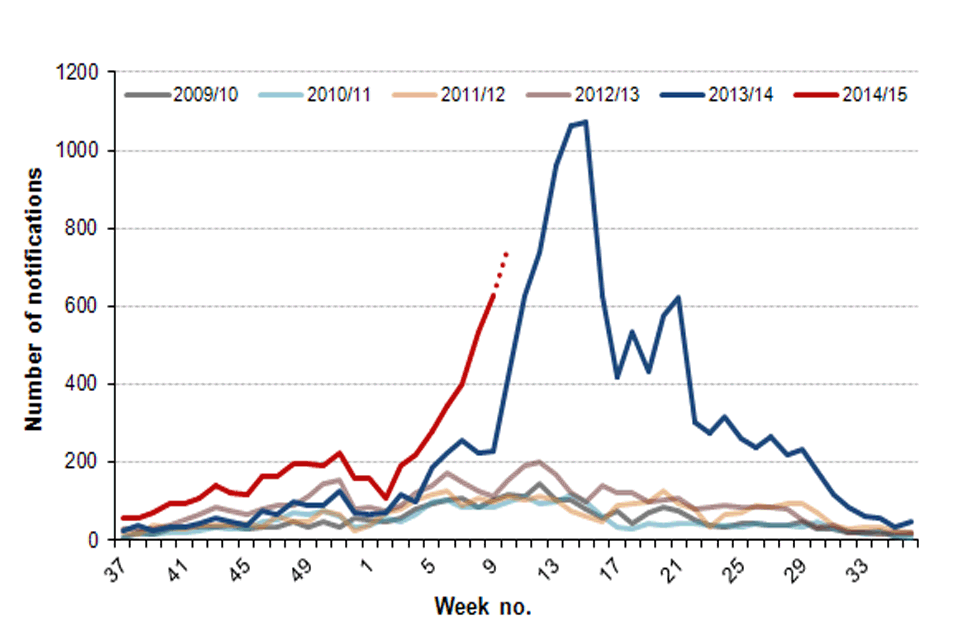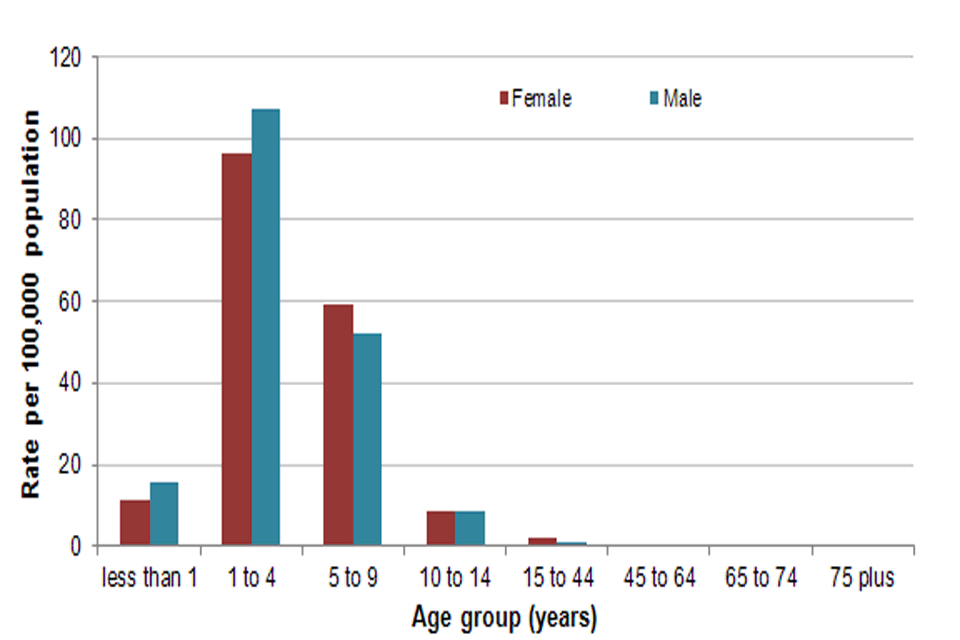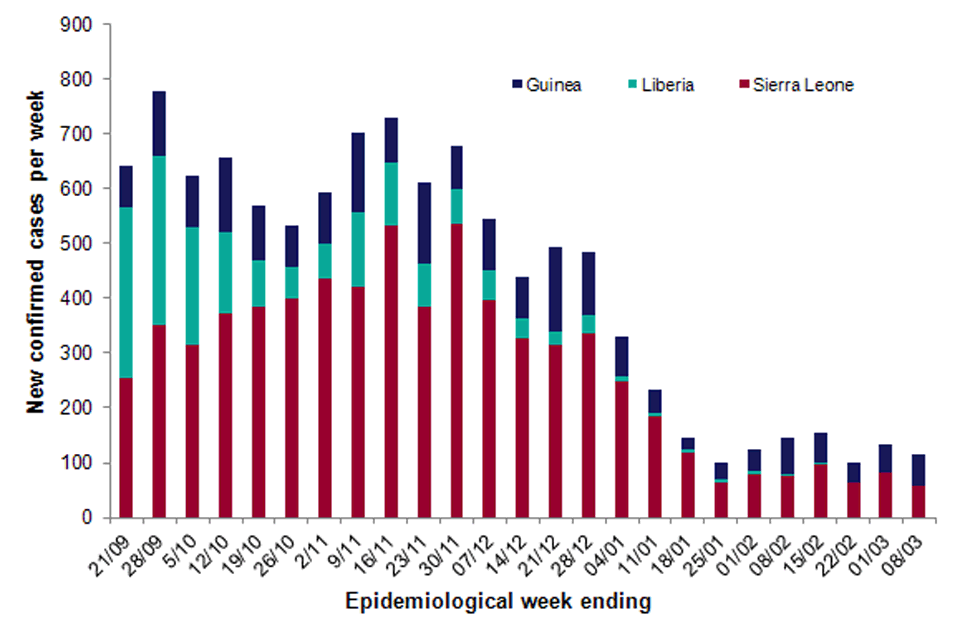HPR volume 9 issue 9: news (13 March)
Updated 29 December 2015
1. Group A streptococcal infections: second update on seasonal activity, 2014/15
High levels of scarlet fever continue to be notified in England, with current weekly totals exceeding the record levels seen at this point last season (2013/14) [1]. Steep weekly increases continue to be reported across the country as the peak season for scarlet fever approaches, with sentinel surveillance of GP consultations also showing escalating rates of consultations [2].
Routine laboratory reports of invasive group A streptococcal (iGAS) disease are currently within normal seasonal levels.
Alerts have been sent to local authorities, GPs, microbiologists and paediatricians to raise awareness of the national increase in scarlet fever, highlighting the signs and symptoms and actions to be taken for every case, including prompt notification to local health protection teams, swabbing when uncertain of diagnosis or if case is part of an outbreak, prompt antibiotic treatment and advising 24 hours exclusion [3]. Due to rare but potentially severe complications associated with GAS infections, continued vigilance is recommended.
1.1 Scarlet fever
Routine monitoring is showing week-on-week increases in scarlet fever notifications as we approach the height of the season with 754 notifications for patients in England in week 10 of 2015. This brings the total number of notifications of scarlet fever made to Public Health England (PHE) so far this season (weeks 37, 2014, to 10, 2015) to 5746, compared with 2833 to for the same period last season (figure 1).
Scarlet fever notifications remain high across all parts of England, particularly in the Midlands and in northern parts of the country. The highest rates of notified cases so far this season are in the East Midlands at 15.9 per 100,000 population, followed by Yorkshire and the Humber (15.7), Cheshire and Merseyside (15.0), the North East (14.4) and Cumbria and Lancashire (13.2). London has the lowest scarlet fever notification rates (6.3/100,000).
The age distribution of scarlet fever cases notified this season remains similar to previous years, with 89% of cases reported in children under 10 years of age (median 4 years; range <1 year to 87 years). Notifications are evenly distributed by sex across all age groups. The incidence of scarlet fever in children ranged from 8.8 per 100,000 population in 10 to 14 year-olds to 111.0 per 100,000 population in 1 to 4 year-olds this season (figure 2). Five per cent of notifications this season were in adults (≥18 years old) with rates of <1 per 100,000 population in those over 44 years old.

Figure 1. Weekly scarlet fever notifications in England, 2008/09 onwards (Dashed line indicates that numbers may increase as further notifications expected.)

Figure 2. Rate per 100,000 population scarlet fever notifications in England by age and sex, week 37, 2014, to 10, 2015
1.2 Invasive Group A Streptococcus
The number of routine laboratory reports of iGAS has increased in line with normal seasonal patterns. While sharp increases were seen around week 4, iGAS reports are now within normal levels (figure 3). A total of 672 cases of iGAS infection were reported so far this season (week 37, 2014, to week 9, 2015), slightly above average for the same period over the last 5 years (641) but within the reported range for this period (562 to 708).
Eight English regions have reported higher than average (season 2009/10 to 2013/14) iGAS cases so far this season (weeks 37 to 9); Kent, Surrey & Sussex (62), West Midlands (77), Thames Valley (28), North East (38), Yorkshire and the Humber (73), Devon, Cornwall & Somerset (40), Cheshire & Merseyside (37) and Wessex (33)
The median age of patients with iGAS infection so far this season is 63 years (range <1 year to 105 years), which is slightly higher than was reported at the same point last season (61 years) but within the normal range (54 years to 63 years over the past five seasons). Fifty-three per cent of iGAS cases this season have been reported in males (previous five season average 50%; range 45% to 52%).

Figure 3. Weekly routine laboratory reports of iGAS infection, England, 2008/09 onwards (Dashed line indicates that numbers may increase as further notifications expected)
Analysis of iGAS emm strain diversity from isolates sent to the national reference laboratory indicates emm st1 to be the most common this season (26% of referrals; September 2014 to February 2015) followed by emm st3 (13%), emm st12 (10%) and emm st89 (10%). No identification of novel strains or unusual increases in specific strain types have been seen so far this season.
Antimicrobial susceptibility results from routine iGAS laboratory reports for the season so far indicate erythromycin non-susceptibility is within the usual range at 4%. The susceptibility testing of iGAS isolates against other key antimicrobials (tetracycline, 12%; clindamycin, 2%; and penicillin, 0%) indicate no changes in resistance, although sensitivity reporting remains low (<50% isolates) at this stage of the season.
The further acceleration in the number of notifications of scarlet fever this season confirm that this is the second season in a row in which large increases in the number of cases have been observed compared to previous years. Weekly numbers are expected to continue to rise until peak season which is likely to be reached any time between now and the next four weeks. Whilst heightened awareness and improved diagnosis and/or notification practices, may explain some of the elevation this season, the high number of cases currently being notified suggests a genuine elevation in disease incidence and therefore remains of concern. The reasons behind this increase are unclear but may be attributable to long-term natural cycles in disease incidence. Close monitoring, rapid and decisive response to potential outbreaks and early treatment of scarlet fever remains essential, especially given the potential complications associated with GAS infections.
Whilst invasive GAS disease reports remained within the usual bounds last season, current activity is slightly elevated in some parts of the country. As such, clinicians, microbiologists and Health Protection Teams should continue to be mindful of potential increases in invasive disease and maintain a high degree of suspicion in relevant patients. Early recognition and prompt initiation of specific and supportive therapy for patients with iGAS infection can be life-saving. Invasive disease isolates and those from suspected clusters or outbreaks should be submitted to the Respiratory and Vaccine Preventable Bacteria Reference Unit at Public Health England, 61 Colindale Avenue, London NW9 5HT.
Relevant guidelines and FAQs are available on the PHE webpages, as follows:
- Guidelines on infection control in schools and other childcare settings, including recommended exclusion periods for scarlet fever and new guidelines on management of scarlet fever outbreaks:
- FAQs on scarlet fever
- Guidelines for the management of close community contacts of invasive GAS cases and prevention and control of GAS transmission in acute healthcare and maternity settings.
1.3 References
-
PHE (November 2015). Group A streptococcal infections: seasonal activity, 2014/2015, HPR 8(44): infection (news) report.
-
PHE. GP in-hours consultations bulletin: 5 March 2015, week 9.
2. Ebola virus disease: international epidemiological summary (as at 8 March) and update
As of 8 March 2015, the World Health Organization (WHO) reports a total of 24,282 clinically compatible cases (CCC) of Ebola virus disease (EVD), including 9,976 deaths, associated with the West African outbreak (see table). Provided case totals and, particularly, deaths are known to still under-represent the true impact of the outbreak in West Africa. While the majority of cases have been reported from Guinea, Liberia and Sierra Leone, cases have also been reported from Mali, Nigeria, Senegal, Spain, the United Kingdom (UK) and the United States of America (USA). On 7 March the UK reclaimed its EVD free status.
Ebola virus disease international epidemiological information as at 8 March 2015.
| Country | Total CCCs | Total deaths | Current status |
|---|---|---|---|
| Guinea | 3285 | 2170 | Ongoing transmission |
| Liberia | 9343 | 4162 | Ongoing transmission |
| Sierra Leone | 11,619 | 3629 | Ongoing transmission |
| Mali | 8 | 6 | EVD free |
| Nigeria | 20 | 8 | EVD free |
| Senegal | 1 | 0 | EVD free |
| Spain | 1 | 0 | EVD free |
| UK | 1 | 0 | Single imported case |
| USA | 4 | 1 | Awaiting EVD free status |
| TOTAL | 24,282 | 9976 | – |
There has been no significant decline in overall case incidence since January 2015 however; a recent contraction of the geographical distribution of cases will now enable response efforts to focus on a smaller area. Constant vigilance is required in Guinea, Liberia and Sierra Leone to prevent further geographical dispersion of cases. For the second consecutive week (to 5 March), Liberia reported no new confirmed EVD cases. In contrast, in Guinea and Sierra Leone there were a total of 116 new confirmed cases (58 in Guinea and 58 in Sierra Leone) reported in the past week (to 8 March) (see figure). The complex nature of this outbreak means that EVD control in West Africa will require significant and sustained effort.

Number of new confirmed cases reported per week (21 September 2014 to 8 March 2015) in countries reporting persistent transmission
In Guinea, the new cases were clustered in an area around and including the capital Conakry (13 cases), with the nearby prefectures of Boffa (2 cases), Coyah (8 cases), Dubreka (5 cases), Forecariah (28 cases), and Kindia (2 cases) the only other prefectures to report cases. The number of confirmed EVD deaths occurring in the community has risen for the past 3 weeks in Guinea, suggesting that there are still significant challenges in terms of contact tracing and community engagement. Of a total of 40 EVD-positive deaths reported in the last week, 24 occurred in the community.
In Liberia, no new confirmed cases have been reported in the last two weeks (to 8 March). The situation in Liberia appears promising however, it is important to note that even when no ongoing transmission is reported in Liberia, the porous nature of its borders with other affected countries means that the risk of further outbreaks continues until West Africa is EVD free.
Sierra Leone, for the first time since June 2014, has not exceeded the weekly EVD incidence of Guinea. Cases were reported from 5 north and western districts clustered around the capital Freetown, which reported 27 new confirmed cases. The neighbouring districts of Bombali (6 cases), Kambia (7 cases), Port Loko (12 cases) and Western Rural (6 cases) also reported cases.While there has been substantial improvement in the epidemiological situation in Sierra Leone in the last two months, the fluctuating trend in new cases in certain districts, as well as ongoing reports of community resistance and reports of unsafe burials, may impede control measures.
A confirmed case in a British healthcare worker was aeromedically evacuated to the UK on 12 March from Sierra Leone. The patient is currently hospitalised in the Royal Free hospital in London.
Further information on the international epidemiological situation can be found in PHE’s weekly Ebola epidemiological update.
3. JCVI advises immunisation programme for MenW disease
The Joint Committee on Vaccination and Immunisation (JCVI) has advised that immunisation should be offered to 14 -18 year-olds to prevent the transmission of meningococcal group W (MenW) disease [1].
This advice follows the recently reported continuing rise in cases of MenW in England since 2009 [2]. Whilst the number of MenW cases and overall risk remains very low, there has been an increase in prevalence with 117 cases last year.
Having reviewed the outbreak in detail and concluded that the increase would be likely to continue in future years if no action was taken, JCVI has advised the Department of Health to implement a vaccination programme for teenagers as soon as possible.
The Department of Health has accepted JCVI’s advice and is now planning the implementation of a combined MenACWY immunisation programme.
3.1 References
- “Independent UK vaccination committee advises immunisation programme for Meningococcal W disease”, PHE press release, 13 March 2015.
- “Continuing increase in meningococcal group W (MenW) disease in England”, HPR 9(7): infection (news) report.
